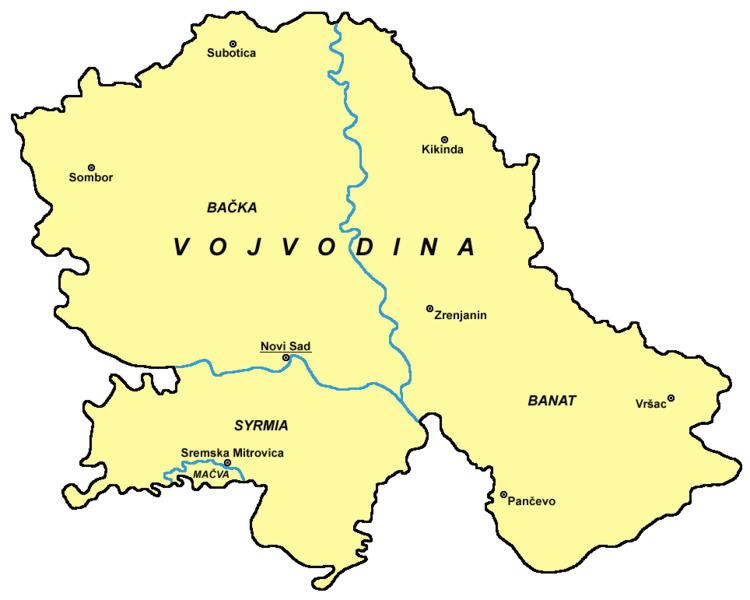According to the 1910 census, the population of the territory of present-day Serbian Banat numbered 566,400 people, including: [1]
Serbs = 229,568 (40.53%)Germans = 125,374 (22.14%)Hungarians = 108,662 (19.18%)Romanians = 73,303 (12.94%)Slovaks = 16,223 (2.86%)Croats = 3,685 (0.65%)According to the 1921 census, the population of Serbian Banat numbered 561,958 people, including: [2]
Serbs and Croats = 240,213 (42.75%)Germans = 126,530 (22.52%)Hungarians = 98,471 (17.52%)Romanians = 67,897 (12.08%)Of the 169 communes in the Serbian Banat, 61 were predominantly South Slav-speaking, 29 German, 27 Magyar, 24 Romanian, 3 Slovak-Czech and 25 mixed.
By religion, the population of Serbian Banat in 1921 included:
Orthodox Christians = 306,414 (54.53%)Roman Catholics = 209,370 (37.26%)Protestants = 39,226 (6.98%)In 1931, the population of Serbian Banat numbered 585,579 people, including: [3]
Serbs = 261,123 (44.59%)Germans = 120,541 (20.58%)Hungarians = 95,867 (16.37%)Romanians = 62,365 (10.65%)Slovaks = 17,900 (3.06%)Croats = 12,546 (2.14%)In 1948, the population of Serbian Banat numbered 601,626 people, including: [4]
Serbs = 358,067 (59.62%)Hungarians = 110,446 (18.35%)Romanians = 55,678 (9.25%)Slovaks = 20,685 (3.44%)Germans = 17,522 (2.91%)Croats = 8,727 (1.45%)In 1953, the population of Serbian Banat numbered 617,163 people, including: [5]
Serbs = 374,258 (60.64%)Hungarians = 112,683 (18.26%)Romanians = 55,094 (8.93%)Slovaks = 21,229 (3.44%)Croats = 10,700 (1.73%)In 1961, the population of Serbian Banat numbered 655,868 people, including: [6]
Serbs = 423,837 (64.62%)Hungarians = 111,944 (17.07%)Romanians = 54,447 (8.3%)Slovaks = 22,306 (3.4%)Croats = 8,381 (1.28%)In 1971, the population of Serbian Banat numbered 666,559 inhabitants, including:
Serbs = 434,810 (65.23%)Hungarians = 103,090 (15.47%)Romanians = 49,455 (7.42%)Slovaks = 22,173 (3.33%)Macedonians = 12,683 (1.90%)Yugoslavs = 10,795 (1.62%)Croats = 7,896 (1.18%)Montenegrins = 3,882 (0.58%)Slovenes = 1,521 (0.23%)In 1981, the population of Serbian Banat numbered 672,884 people, including: [7]
Serbs = 424,765 (65.66%)Hungarians = 90,445 (14.0%)Romanians = 43,474 (6.74%)Yugoslavs = 42,584 (6.6%)Slovaks = 21,392 (3.31%)In 1991, the population of Serbian Banat numbered 648,390 people, including: [8]
Serbs = 423,475 (65.31%)Hungarians = 76,153 (11.74%)Yugoslavs = 42,382 (6.55%)Romanians = 35,935 (5.54%)Slovaks = 19,903 (3.07%)According to 2002 census, the population of Serbian Banat (excluding City of Belgrade's settlements of Borča, Krnjača, Ovča, Padinska Skela, Kovilovo and Besni Fok which are geographically part of Banat) numbered 616,202 people and was composed of:
Serbs = 435,577 (70.69%)Hungarians = 62,890 (10.21%)Romanians = 27,661 (4.1%)Slovaks = 17,994 (2.7%)According to 2011 census, the population of Serbian Banat (excluding City of Belgrade's settlements of Borča, Krnjača, Ovča, Padinska Skela, Kovilovo and Besni Fok which are geographically part of Banat) numbered 534,875 people and is composed of:
Serbs = 398,454 (74.49%)Hungarians = 52,892 (9.88%)Romanians = 22,353 (4.17%)Romani people = 18,547 (3.46%)Slovaks = 16,063 (3%)Macedonians = 7,236 (1.35%)
